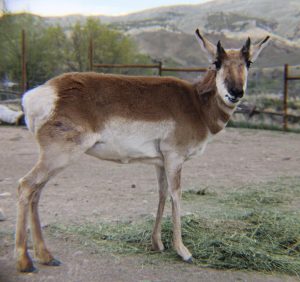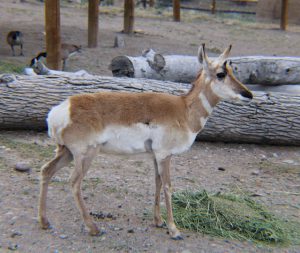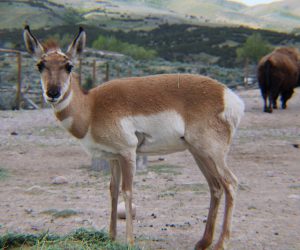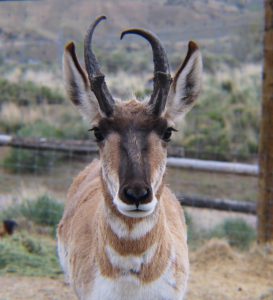Pronghorn (Antilocapra americana)
Taxonomy
Kingdom: Animalia
Phylum: Chordata
Class: Mammalia
Order: Artiodactyla
Suborder: Ruminantia
Family: Antilocapridae
Genus: Antilocapra
Species: Antilocapra americana
Conservation Status in Idaho
Least Concern
Range and Habitat
The pronghorn is endemic to North America and is distributed throughout the plains, basins and deserts of western North America from the southern prairies of Canada to northern Mexico. Pronghorn are primarily found in grassland, sagebrush steppe, chaparral and desert habitat.
Physical Features
Weight: Males, 95–130 lbs (42–59 kg); Females, 90–110 lbs (40–50 kg)
Shoulder height: Males, 2.9 ft (875 mm); Females, 2.8 ft (860 mm)
Length: Males, 4.6 ft (1.4 m); Females, 4.6 ft (1.4 m)
Horn length: Males, 12–20 in (30–50 cm); Females, 3–4 in (7.5–10 cm)
Pronghorn are small barrel shaped ungulates with dense coarse hair. The upper body and outside of the legs is a tan to reddish tan color; the belly, inner legs, cheek and rump patch are white. Males have a broad black band from eyes to snout and a black neck patch. Both male and females have horns. Males have large forking sheaths covering their horns that are shed annually. The sheath is lyre shaped with a pronounced short prong that juts forward. Pronghorns are specialized for cursoriality (running), resulting in enhanced speed, endurance and the inability to jump. They are the fastest known New World mammal with a maximum burst of up to 60 mph (90 kmph) with sustained speeds of 40 mph (65 km/h).
Diet
Pronghorn are herbivores eating stems, leaves, grasses and shrubs. Sagebrush is a particularly important component to their diet.
Lifespan
Pronghorn live between 9-16 years in the wild and captivity.
Reproduction
Pronghorns are polygynous with males defending territories and a small harem of females from March-October. Breeding occurs mid-September through October in the northern range and July-October in the southern range. Gestation is 252 days and births are synchronous with all females in the harem giving birth within a few days of each other. Typically females give birth to single fawns in their first year and twins in the subsequent years. Young are partially weened by three weeks and become sexually reproductive by 16 months old.
Social Behavior and Interaction
Herd composition changes daily, even hourly when food is plentiful. Groups referred to as bands of 3 to 25 are spatially distant but still within visual contact of one another. In fall and winter bands come together to form larger herds (up to 1,000) as protection from predators. The size of bands are influenced by differences in quality of habitat and density and spatial dispersion of individuals.
Dominance hierarchies are maintained by female bands, bachelor bands, and territorial male bands that contain more than one male.
Major Threats
Threats to the pronghorn include reduction of available habitat, fragmentation of habitat, livestock grazing, roads, fences, other barriers, insufficient forage and water, and lack of herd recruitment.




